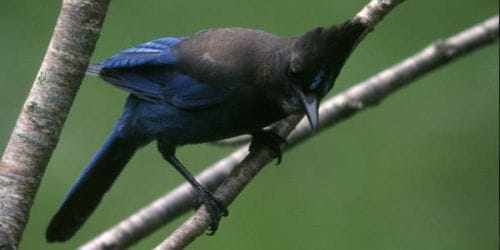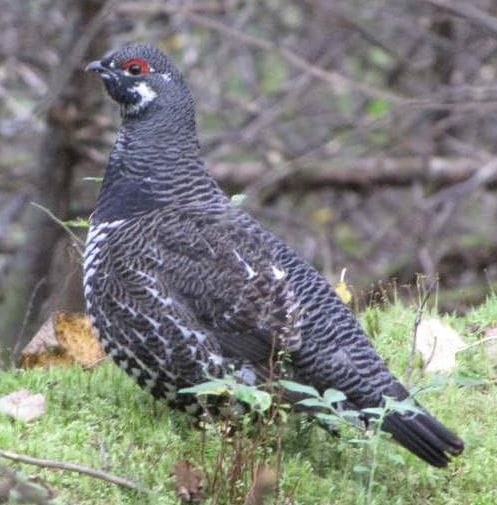There’s a reason why the name of Linnaeus is still spoken with respect more than two centuries after his death. Giving organisms standard names allowed precise communication across cultures and languages. In the birding community, standardization of common names has followed, and is an on-going project (with mixed success.) This is obviously very useful as well — especially now, when birders from vastly different regions communicate casually across the internet.
In some cases, this has increased beauty and precision, saving us from a morass in which every red bird is a Redbird and every blue jay is a Blue Jay. Peregrine Falcon is certainly more elegant than Duck Hawk. And the use of Long-tailed Duck for a waterfowl whose traditional name I decline to type is a small, but real, improvement in the state of civilization as a whole.
Not even all that blue, actually
On the other hand, whenever you standardize language or anything else, you run the risk of local nuance and poetry being lost. In order to avert that, I’d like to sing the praises of a few local common names of some Rocky Mountain birds.
Gray Jay: This drab but charismatic species demonstrates that the more a bird interacts with humans, the more colloquial names it will tend to pick up. Once known as the Canada Jay, but more interestingly by such tags as Camp Robber and Venison Hawk for its habit of hanging around humans and viewing them as a food source. Also known as Meat-bird, Moosebird, and Lumberjack. Best of all, sometimes called Whiskey Jack, a corruption of the Algonquin Wisakedjak, the name of a trickster manitou. (The deity himself, according to the all-knowing internet, was not associated with jays but with cranes.)
American Dipper: Anyone who knows their John Muir knows that the pleasingly archaic name Water Ouzel can be used for this species, as well as for its European cousin the White-throated Dipper. Outside of the Cinclus, Ouzel is also a common name sometimes applied to a variety of Turdus thrushes including the Common Blackbird of Europe, so the literal meaning of the name is “Water Thrush”. But it sounds so much more sophisticated to say Ouzel.
Assorted Galliformes: One of the bird-human interactions that tends to produce a lot of common names is hunting, and names bestowed by hunters will tend to focus on traits important to hunters: how do you find it, where do you find it, and how does it taste? Issues like taxonomy take the back seat. As a result, the White-tailed Ptarmigan is sometimes known as the Snow Grouse, while actual grouse are tagged as follows: Dusky Grouse = Hooter, Ruffed Grouse, = Drummer, Spruce Grouse = Fool-hen. This seems rather hard on the Spruce Grouse.
Fool-hen, guys? Really?
Clark’s Nutcracker: On the other hand, the folk vernacular can be surprisingly insightful about taxonomy and even convergent evolution, as when people call this non-standard corvid a Woodpecker Crow.
Swainson’s Hawk: Further east, where the mountains smooth into prairies, this bird demonstrates a common naming pattern for birds of prey: people call them after the creatures they prey on, dubbing this bird the Locust Hawk or Grasshopper Hawk. Likewise the Peregrine Falcon is the Duck Hawk as mentioned above, the American Kestrel is the Sparrowhawk, and the Osprey is the Fish Hawk.
Northern Flicker: And then there are the times when officialdom changes not only the name, but the whole species, away from the former conventional wisdom. Northern Flicker this species may well be, but Red-shafted Flicker is certainly more descriptive of the majority of the Montana population.
These are just a handful of the better-documented vernacular names. No doubt dozens of descriptive, evocative, and
hilarious handles for birds, some perhaps restricted to a single valley or even to one family, have been lost. Feel free to add any you know in the comments.
(photos courtesy of the US Fish and Wildlife Service. Steller’s Jay by Lee Karney, Spruce Grouse by David Govtaski)















Whiskey Jack is the name that I’ll forever use for Grey Jay. It is far more evocative a name. Where I grew up Roughed Grouse were “Partridge”, Sharp-tailed Grouse were “Chickens” or sometime later “Sharpies”, and Fool Hen were well Fool Hen. They were called that (as far as I know) from their habit of sitting tight relying on cryptic colouring rather than feeling when hunters were about. The other great colloquial name from home was for American Bittern. We called them Shitepokes.
I love the colloquial names of birds, especially birds like these. All those colorful handles for the Gray Jay evoke the days when the early trappers were exploring the northern forests.
As for the Spruce Grouse, my first run in with one of these birds was in Alaska. Unlike its more elusive kin, that bird basically walked right underfoot, possibly even bumping into my leg. A damn Fool Hen if I ever met one.
John M. Levinson and Somers G. Headley conspired in a book called ‘The Birds, The Hunters, the Decoys.’ A section of the book deals with species descriptions and gives colloquial and local names for good shooting birds.
A Ruddy Turnstone for example is known amongst other aliases as a Sea Robin, while Bog Sucker is used by James G. Dickson in his book ‘Wildlife of southern forests: habitat and management’ to describe a Woodcock.
Names changed according to location and even season or age, depending on the birds’ appearance. The Grey Plover uses the appellation, May Cock in spring. The young birds go by the name, Pale Bellies and older birds might be called Silver Plovers.
Clare: I’m glad someone still uses Whiskey Jack! I’ve heard Shitepoke before – don’t know if I want to know the reasoning behind it…
Mike: Ok, maybe that one was a Fool Hen.
Redgannet: I know that Woodcocks have a whole lot of nicknames; the one I know best is Timberdoodle, but Bog Sucker is a bit more evocative.
One of the most amazing websites I ever found, and one I go back to regularly, is Patuxet Bird Observatory’s List of Obsolete Bird Names:
http://www.pwrc.usgs.gov/research/pubs/banks/obspart1.htm
Some winners from that list, for American Bittern, “Dunk-a-roo” and for Horned Grebe, “Hell-diver”. There are tons more.
Nate: What a great site. Bookmarked!
My experience with Spruce Grouse is very similar to what Mike wrote, yet I – being a guy with the friendliest of intentions – would never come up with a name like Fool Hen. It is more of a Friend Hen, really.
Sorry for under-sophisticated comment, am commenting from a public computer at Baku airport. Brag, brag, brag. No birds though, so life could be worse, but it could also be much, much better.
OK so whats wrong with calling it an Oldsquaw? You wont even mention it? Is it because of what squaw really means? I dont care I dont like long tailed duck. Oldsquaw definitely has more character to it. Darn ol political correctness creeping in as always.
It’s a term that’s offensive to a lot of Native American women. Not insulting people I don’t even know may be political correctness, but it’s also basic good manners.
Okay, this is a bit belated, but nevertheless:
As a young German exchange student in 1987 to Canada, I got myself some field guides that called Clangula hyemalis “Oldsquaw”. I thought and still think that this name simply sounds silly, regardless of its meaning. The fact that it is insulting to many (which I only learned now through Carrie’s post) makes it sound even more silly.
When I returned to North America in 2005 I got myself some new field guides – obviously – in which the bird was called Long-tailed Duck. I don’t think that this is a much better-sounding name, but the fact that it isn’t insulting to anybody makes it my clear favourite.
Next time I am in North America, I might just call it by the English translation of its German name: Ice Duck.
And not insulting people has nothing to do whatsoever with being politically correct. It has to do with Wheaton’s Law: Don’t be a Dick!
To this day my whole family calls Seagulls of all kinds “Shit Hawks” How more descriptive can one be!? Where exactly the term came from originally and how widespread it is I don’t know.
P.S. We have been calling them that for over 50 years, so it predates any connection to Mr. Lahey of Trailer Park Boys.
I should mention: Ptarmigan are, in fact, grouse, taxonomically speaking. They both belong in the subfamily Tetraoninae, and most dictionary definitions say that ptarmigan are grouse. For some reason, birders forget that ptarmigan are grouse.
Also, the terms Yellow-shafted and Red-shafted Flickers are still valid names for the individual subspecies.